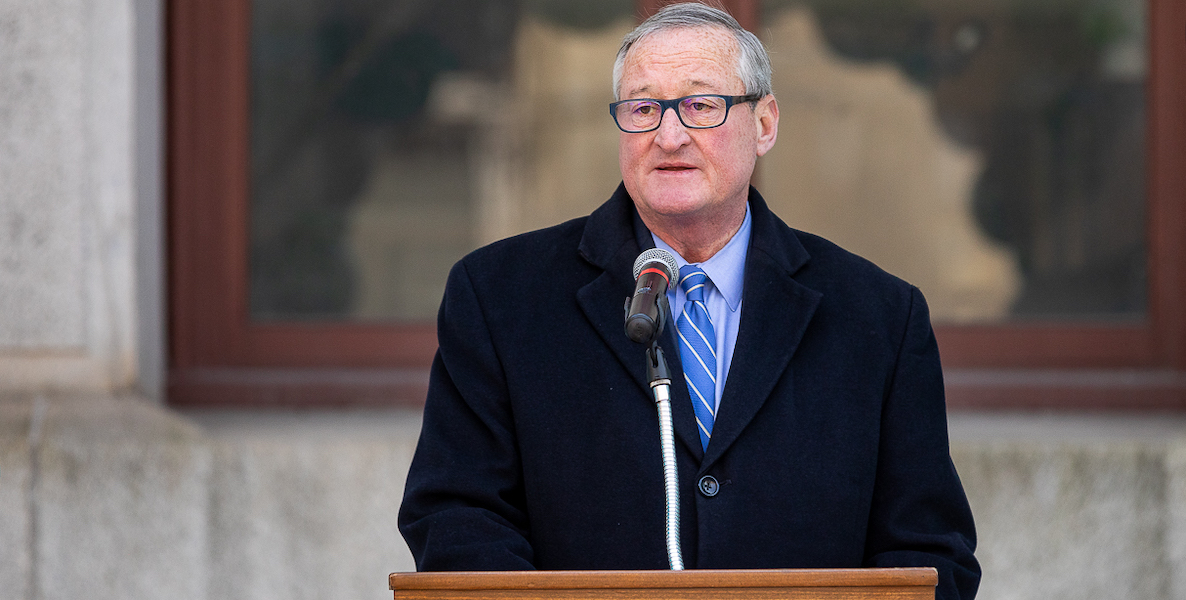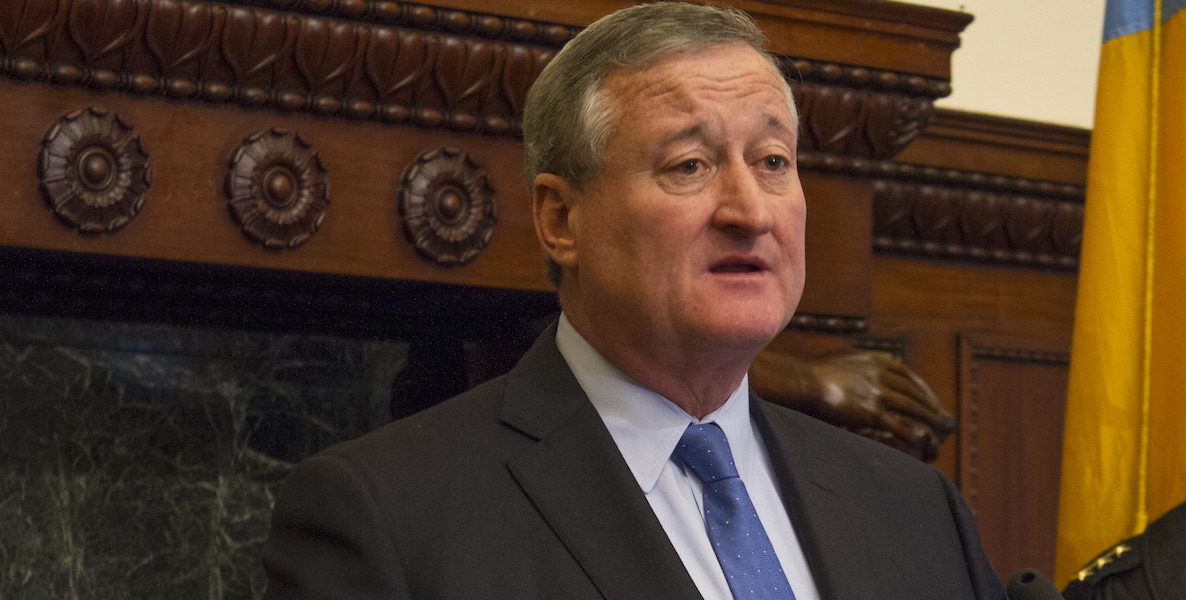Early last month, Mayor Kenney gave his annual budget address. I, along with many in the business community, had been hoping for a bold economic development plan, something beyond soda taxes and funding Pre-K. We didn’t hear that, but the Mayor did reveal something rather stunning: that his proposed budget makes great strides in confronting our ever-worsening pension crisis.
First, Kenney ably laid out the problem. “The City’s annual pension contribution has grown by over 230 percent since fiscal year 2001,” he said. “These increasing pension costs have caused us to cut important public services, while the pension fund’s health has grown weaker. In fact, our pension fund has actually dropped from 77 percent funded to less than 50 percent funded, during the same time our contributions were so rapidly increasing.”
Observing, correctly, that we have on our hands a “systemic problem,” Kenney made his pitch: “I urge Council to adopt the administration’s plan to get the pension fund 80 percent funded in 13 years,” he said. “DC33, our largest union, has already accepted this plan. For future employees, it utilizes a stacked-hybrid model, and for our current employees it requires increased contributions that rise with incomes.”
Wait, what? 80 percent funded by 2031? That was easy. All it takes is asking current city employees to pay in a little more, and future employees to accept a retirement program that’s a little less generous?
“States and cities routinely pick a very optimistic assumption,” Vague says. “Anything in the 7 or 8 percent range is highly optimistic. The return in the last decade has not been anywhere close to that. And if it’s even a little below your projection, the computation is so sensitive, it makes for a very different outcome a few years down the road.”
To be clear, this “fix” doesn’t even follow the private sector reform trend, whereby defined contribution plans have been replaced by 401k plans. We know that what makes the most mathematical sense is that all new city hires be on 401k plans instead of conventional pensions. But that’s tricky politically; in a sign of just how intractable a problem this is, there is widespread resistance not only to messing with the pension plans of existing city workers—but also to changing the plan for those who haven’t even been hired yet.
That’s because we’re in widespread denial as to how much of a crisis we’re in. There’s a difference of some $6 billion between the fund’s assets and its obligations to city workers. That means that 16 percent of the city’s annual budget goes to propping up the unfunded balance Kenney speaks of. (Kenney, by the way, doesn’t exactly have clean hands when it comes to our pension mess; it was then-Councilman Kenney’s 2007 law that removed the requirement that the fund be at least 76.7 percent funded before bonuses are paid out.)
As the shortfall grows, it diverts more and more spending from other critical areas—education and infrastructure among them. This year, the city will contribute some $630 million to the pension fund—more than the city takes in in property taxes. Just imagine the return on investment we’d see if our pension obligations weren’t draining our general fund. For one thing, we likely wouldn’t have needed a regressive tax on those who drink sweetened beverages to pay for a laudable pre-K program.
So given the sheer size of the hole—$6 billion!—could Kenney’s tweak to the current system be close to a panacea? Hardly—though it is an incremental step in the right direction. The question then becomes: Are incremental fixes helpful, or is that just code for more of what generations of politicians have always done: Kick the fiscal can down the proverbial road, convincing themselves they’re simply living to fight another day?
I’m no fiscal savant, so I turned to a couple: Sam Katz and Richard Vague. Katz is the former Chair of PICA, the city’s fiscal oversight board, and a serial candidate for mayor with a background in public finance. Vague is a Center City venture capitalist, philanthropist and author of 2014’s The Next Economic Disaster: Why It’s Coming and How to Avoid It. Vague and his team of heterodox economists, as part of their challenge to conventional wisdom—they hold that a certain level of private debt is the key factor in triggering economic calamity—has been studying the pension crisis that looms across the country.
“I hasten to point out that Philadelphia is not even close to being unique in this,” Vague says. “A majority of cities and states have this exact problem. They’re only partially funded and have no reasonable basis for expecting to get back to a stable funding level anytime soon. What suffers are other areas of spending in cities and states. People fuss at me for saying that — ‘How dare you suggest we can’t do it all? We can have roads and education and a generous pension.’ But the math is the math, folks.”
Collectively, Vague’s research shows, the United States has $2 trillion in unfunded pension obligations. “And it does not look like it is a solvable problem. At all. By anyone.”
Katz has a good test for determining whether Kenney and Council really believe the mayor’s proposed plan will get the fund to 80 percent funded in 13 years: “Ask them if they’re willing to bet their pensions on that,” he says.
Vague’s normally a jovial guy, which makes me do a doubletake. “Wait,” I say. “That’s really depressing.”
Vague smiles at my naivete. “It is a depressing scenario,” he says, “but it’s pervasive and structural.”
What about Kenney’s plan? “It does not get you to 80 percent,” Vague says. “But we don’t want to be critical because it is at least a positive step. We guess that, without these changes, the pension runs out in a decade. This pushes that out a few years. So it’s a positive step—but it doesn’t get you to 80 percent funded.”
Like Vague, Katz gives the Kenney administration credit for doing something. “Their plan moves the needle a little bit,” he says.
But the math of Kenney’s budget projection, it turns out, is ripped from the pages of a familiar playbook. The Kenney plan assumes that the fund’s rate of investment return will be 7.7 percent.
“I’d like to meet that broker,” says Katz. It’s an old trick, of the rosy scenario variety. The administration points to the fact that other cities make similar assumptions; Katz says they’re all “self-delusional” and that anticipating outlandish investment growth is essentially a political decision, because a reasonable assumption of, say, 3 percent portfolio growth would drastically throw off the city’s budget and keep the administration from spending what it told voters it would spend. “This is a crisis in full hiding,” he says, “and our solution over a long period of time has been to engage in denial.”
Vague agrees. “States and cities routinely pick a very optimistic assumption,” he says. “Anything in the 7 or 8 percent range is highly optimistic. The return in the last decade has not been anywhere close to that. And if it’s even a little below your projection, the computation is so sensitive, it makes for a very different outcome a few years down the road.”
And just whose judgment are we relying on for managing a pension fund of nearly $5 billion in assets? Our Board of Pensions consists of nine members, chaired by the city’s Director of Finance, and consisting of the Managing Director, City Solicitor, City Controller, Personnel Director, and four members elected by the city’s civil service employees. “Collectively, they have zero experience in investment finance,” Katz says. “[Finance Director] Rob Dubow is a smart guy, but he’s not a pension guy. No one on the board is really qualified to govern a pension fund.”
Of course, the Board members would say that’s why they use professional managers—though the trend of late is for cities to rid themselves of professional investment managers because of the exorbitant fees they charge. Katz says it would have been hard to do worse than the Board of Pensions did these last few decades. “If, 20 years ago, the city had simply invested in Warren Buffett’s Berkshire Hathaway stock, we wouldn’t be in the shape we’re in,” he says.
Vague is quick to point out, however, that Philadelphia’s pension woes are not unique. Nationwide, cities and states follow the same “extend and pretend” pension fund strategy. Put a few band-aids on your pension fund shortfall, and maybe it’s something you don’t have to really face while in office. Which might not be irrational—especially since there’s little at the local or state level that can be done to solve the problem. (The unfunded state pension amount is up to a staggering $74 billion)
This year, the city will contribute some $630 million to the pension fund—more than the city takes in in property taxes. Just imagine the return on investment we’d see if our pension obligations weren’t draining our general fund. For one thing, we likely wouldn’t have needed a regressive tax on those who drink sweetened beverages to pay for a laudable pre-K program.
Katz argues that the city could do more, like renegotiate pension fund terms while maximizing worker protections, and selling off city-owned assets and dedicating the proceeds to the pension fund. Philadelphia, after all, is one of the few remaining municipalities in the gas, water, and airport businesses. “Across City Line Avenue, residents get their water and gas from private companies and that seems to work fine for them,” he says.
For his part, Vague has a national prescription—a type of grand bargain, that would involve a federal bailout and the placing of state and city pension funds under the Employee Retirement Income Security Act (ERISA) of 1974—which governs corporate pension plans and which state and city plans were exempted from. “That left the door wide open for states and cities to do what they wanted in terms of how they fund their programs and structure their projections,” he says. “That’s a fundamental reason we have this problem today.”
Of course, the notion that this federal government will come to the rescue is laughable on its face. Throughout the nation, our public pension crisis is a slow bleed—something that will quietly continue to drain key public investments. Some states and cities will get to a crisis point, as Detroit experienced. But, Vague warns, “a national consensus that something must be done? That’s not in the cards.”
How did we get here? During the boom post-World War II years, we built the fasting growing economy in human history thanks to what Vague calls “heroic” investments in things like the GI Bill of Rights and the Interstate Highway System. But we had low debt levels then; we could build by borrowing. We structured generous pension programs, unaware that the good times would come to an end.
Now that we’re maxed out and can’t keep up with our obligations, our elected leaders are less reformers and more political pointillists, a dab here and a deft touch there…but what they’re really doing is just putting off judgment day. Katz has a good test for determining whether Kenney and Council really believe the mayor’s proposed plan will get the fund to 80 percent funded in 13 years: “Ask them if they’re willing to bet their pensions on that,” he says.
So here’s a radical thought: Maybe the thing to do is to no longer kick the can down the road, to stop the incremental tweaks. It took a crisis for Detroit to ultimately rise from its ashes, after all, and maybe other cities and states should follow suit.
When I run past Vague the idea that maybe we should just pull off our band-aids, he smiles. “That’s an outlandish thought, of course,” Vague says. “You’re suggesting a form of brinksmanship.” And then his smile dissipates. In the mid-20th Century, during the boom years, he explains, the best job you could have was to be a governor or mayor of a big city. How things have changed. “All I can say is, I’m glad I’m not a governor or mayor today,” Vague says, shaking his head.
Header Photo: Mayor Jim Kenney addresses the crowd at the annual Chamber of Commerce Luncheon. Copyright City of Philadelphia. Photograph by Samantha Madera.





